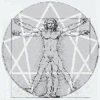“My ballet is not a ‘mystery,’” said G. “The object I had in view was to produce an interesting and beautiful spectacle. Of course there is a certain meaning hidden beneath the outward form, but I have not pursued the aim of exposing and emphasizing this meaning. An important place in the ballet is occupied by certain dances. I will explain this to you briefly. Imagine that in the study of the movements of the heavenly bodies, let us say the PLANETs of the solar system, a special mechanism is constructed to give a visual representation of the laws of these movements and to remind us of them. In this mechanism each PLANET, which is represented by a sphere of appropriate size, is placed at a certain distance from a central sphere representing the sun. The mechanism is set in motion and all the spheres begin to rotate and to move along prescribed paths, reproducing in a visual form the laws which govern the movements of the PLANETs. This mechanism reminds you of all you know about the solar system. There is something like this in the rhythm of certain dances. In the strictly defined movements and combinations of the dancers, certain laws are visually reproduced which arc intelligible to those who know them. Such dances are called ‘sacred dances.’ In the course of my travels in the East I have many times witnessed such dances being performed during sacred services in various ancient temples. Some of these dances are reproduced in The Struggle of the Magicians.’ More-over there are three ideas lying at the basis of “The Struggle of the Magicians.’ But if I produce the ballet on the ordinary stage the public will never understand these ideas.” Fragments: One
What interested me in this talk was that G. spoke of the PLANETs and the moon as living beings, having definite ages, a definite period of life and possibilities of development and transition to other planes of being. From what he said it appeared that the moon was not a “dead PLANET,” as is usually accepted, but, on the contrary, a “PLANET in birth”; a PLANET at the very initial stages of its development which had not yet reached “the degree of intelligence possessed by the earth,” as he expressed it. Fragments: One
“But organic life is also in the world. What then is ‘world’ for organic life? “To this we can answer that for organic life our PLANET the earth is ‘world.’ “But the earth is also in the world. What then is ‘world’ for the earth? ” ‘World’ for the earth is the PLANETary world of the solar system, of which it forms a part. Fragments: Four
“The chain of worlds, the links of which are the Absolute, all worlds, all suns, our sun, the PLANETs, the earth, and the moon, forms the ‘ray of creation’ in which we find ourselves. The ray of creation is for us the ‘world’ in the widest sense of the term. Of course, the ray of creation does not include the ‘world’ in the full sense of the term, since the Absolute gives birth to a number, perhaps to an infinite number, of different worlds, each of which begins a new and separate ray of creation. Furthermore, each of these worlds contains a number of worlds representing a further breaking up of the ray and again of these worlds we select only one — our Milky Way; the Milky Way consists of a number of suns, but of this number we select one sun which is nearest to us, upon which we immediately depend, and in which we live and move and have our being. Each of the other suns means a new breaking up of the ray, but we cannot study these rays in the same way as our ray, that is, the ray in which we are situated. Further, within the solar system the PLANETary world is nearer to us than the sun itself, and within the PLANETary world the nearest of all to us is the earth, the PLANET on which we live. We have no need to study other PLANETs in the same way as we study the earth, it is sufficient for us to take them all together, that is to say, on a considerably smaller scale than we take the earth. Fragments: Four
“According to this idea the moon is still an unborn PLANET, one that is, so to speak, being born. It is becoming warm gradually and in time (given a favorable development of the ray of creation) it will become like the earth and have a satellite of its own, a new moon. A new link will have been added to the ray of creation. The earth, too, is not getting colder, it is getting warmer, and may in time become like the sun. We observe such a process for instance in the system of Jupiter, which is a sun for its satellites. Fragments: Five
‘Take for instance man. He feeds on ‘hydrogen’ 768, breathes ‘hydrogen’ 192, and lives in ‘hydrogen’ 192. There is no other being like him on our PLANET. Although there are beings higher than he is. Animals such as the dog can feed on ‘hydrogen’ 768 but they can also feed on a lower ‘hydrogen’ not 768 but approaching 1536, food of a kind impossible for man. A bee feeds on a ‘hydrogen’ much higher than 768, even higher than 384, but it lives in a hive in an atmosphere where man could not live. From an outward point of view man is an animal. But he is an animal of a different order from all other animals. Fragments: Sixteen
